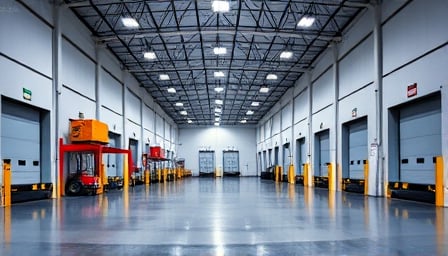Corporate Analysis: Amazon’s Strategic Moves and Their Implications for Heavy‑Industry Capital Allocation
Amazon’s market‑capitalization has remained robust, with its equity price stabilising near the 52‑week high despite short‑term volatility. This stability is a signal to capital allocators that the company’s long‑term business model—combining retail logistics, cloud computing, and media distribution—continues to generate resilient cash flows. In the context of global industrial capital expenditure trends, Amazon’s recent strategic initiatives illustrate the convergence of digital infrastructure investment with traditional manufacturing and supply‑chain logistics.
1. Logistics Infrastructure: Expanding Physical Footprint for Digital Demand
Amazon’s partnership with Hertz represents a strategic expansion of its automotive‑logistics portfolio. By integrating Hertz’s rental fleet with Amazon’s existing delivery network, the company can:
- Increase last‑mile delivery capacity through a hybrid model that leverages both fixed‑route vans and on‑demand rental vehicles.
- Reduce vehicle idle time by synchronising fleet deployment with real‑time demand forecasts derived from its advanced AI‑driven logistics algorithms.
- Mitigate supply‑chain disruptions that have plagued the sector during the pandemic by diversifying the modal mix and adding flexible, short‑term rental options.
From an engineering perspective, this collaboration necessitates the deployment of sophisticated telematics and fleet‑management systems. The integration of vehicle telematics data into Amazon’s warehouse‑to‑delivery orchestration platform will improve predictive maintenance schedules and fuel‑efficiency models, directly impacting productivity metrics such as units delivered per vehicle hour and fleet utilisation rate.
2. Media and Streaming: Capitalising on Content‑Driven Logistics
Prime Video’s surge in viewership has prompted Amazon to allocate significant capital to content production, distribution networks, and edge‑compute infrastructure for adaptive streaming. The company’s investment in adaptive bitrate streaming and edge caching reduces latency for end‑users and decreases backbone bandwidth costs—an efficiency gain that translates into lower operating expenses for Amazon Web Services (AWS) and improved scalability of the media platform.
In the broader heavy‑industry context, these investments mirror the trend of digital twins and real‑time data analytics applied to manufacturing lines. By adopting similar principles—such as predictive analytics for content delivery and real‑time optimisation of streaming paths—Amazon is effectively creating a model that can be replicated in manufacturing supply chains, where data‑driven scheduling and predictive maintenance can reduce downtime by up to 25 %.
3. Workforce Dynamics: Impact of H‑1B Policy Changes
Amazon’s advisement that employees holding H‑1B visas return to the United States before a forthcoming policy change underscores the company’s reliance on a global talent pool for both technical and operational roles. The potential relocation of skilled workers could affect:
- Knowledge transfer rates between global fulfillment centres and U.S. headquarters, which may slow the rollout of new automation initiatives.
- Capital expenditure schedules, as workforce availability directly influences the pace at which new robotics and conveyor‑line upgrades can be deployed.
- Regulatory compliance costs, particularly in the context of labour‑rights legislation that increasingly intersects with immigration policy.
From an engineering standpoint, the need to maintain a cohesive, highly skilled workforce is critical for the successful implementation of Industry 4.0 solutions, which rely heavily on cross‑functional teams that blend software engineering, mechanical design, and data science.
4. Regulatory and Infrastructure Considerations
Amazon’s expansion into automotive logistics and media streaming is subject to a complex regulatory landscape:
- Transportation Safety and Emission Standards: The use of rental vehicles for freight must comply with federal and state regulations governing commercial vehicle emissions, potentially necessitating the procurement of hybrid or electric fleets.
- Content Licensing and Intellectual Property Laws: Prime Video’s global reach exposes Amazon to varying jurisdictional requirements, influencing the design of its distribution network and necessitating robust digital rights management (DRM) systems.
- Data Privacy Regulations: The collection of telemetry data from vehicles and streaming devices must align with GDPR, CCPA, and forthcoming AI‑ethics frameworks, affecting the architecture of data‑storage and processing facilities.
Infrastructure spending in the United States—particularly in 5 G rollout and high‑capacity fibre‑optic networks—provides a complementary backdrop. Amazon’s continued investment in edge computing and regional data centres is poised to benefit from these enhancements, reducing latency for both streaming services and logistics operations.
5. Capital Expenditure Trends and Productivity Metrics
The confluence of these factors signals a broader shift in corporate capital allocation strategies:
- Shift towards Digital‑Physical Hybrid Models: Companies are increasingly blending digital infrastructure with physical assets (e.g., Amazon’s logistics‑cloud integration), which requires capital budgets that account for both hardware and software amortisation.
- Emphasis on Predictive Analytics and AI: Investment in AI‑driven planning tools can improve productivity metrics such as cost per unit and cycle time, aligning with industry benchmarks for lean manufacturing.
- Sustainability as a Cost Driver: Compliance with environmental regulations (e.g., vehicle emissions, data‑centre cooling) necessitates capital outlays for green technologies, but can yield long‑term savings through reduced energy consumption.
Amazon’s case demonstrates that robust market capitalization and strategic diversification can serve as a buffer against regulatory uncertainty and supply‑chain volatility, while simultaneously enabling the deployment of next‑generation manufacturing and logistics technologies.
In summary, Amazon’s recent strategic moves—expanding automotive logistics, scaling media infrastructure, managing workforce transitions, and navigating regulatory landscapes—illustrate the complex interplay between capital investment decisions, productivity optimisation, and industrial innovation. These dynamics provide valuable insights for stakeholders across the heavy‑industry sector seeking to align their own capital expenditure strategies with emerging technological and economic trends.
